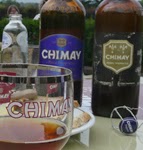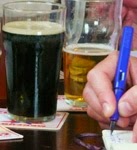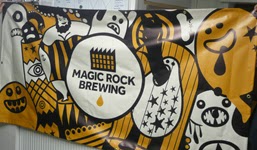Hops A-Z: L is for Lupulin
Take a hop cone and cut in in half. If you don't have one handy, borrow this picture.
Inside the bracts - the divisions of the cone - there's a bunch of yellowy-gold glands. They're full of resins, some of which have been secreted and formed a yellowy 'dust' on the hop. Those soft resins carry the chemistry that make beer aromatic and bitter. Ladies and gentlemen, behold the hop's treasure - lupulin.
It was named as such by Doctor Ansel W Ives of New York in 1820; noticing a yellow powder that had collected in a bag of three-year-old hops, he declared: " I have not been able to find any notice of this powder in books and know not that it has been designated by any appropriate term. In the following inquiry therefore it will be called Lupulin".
Those glands remain swollen with lupulin until they're ruptured. Hot wort will break the membrane; so do your fingers when you rub a hop cone between them. And so does a pellet mill; once crushed the glands oxidise up to five times quicker than whole hops so pellets need to be foil packed as soon as possible and stored in cartons robust enough to be stacked.
Once they're ruptured, what does a lupulin gland give you? Soft resins. Essential oils. The resins contain alpha-acids (contributing bitterness when boiled); the quantity and quality of lupulin in a cone determines the alpha acid content. The oils contain hundreds of volatile companants, including the hydrocarbon terpene that adds aroma, humulene.
That's a lot of chemistry going on in that gland. For which, beer lovers are eternally thankful.
Inside the bracts - the divisions of the cone - there's a bunch of yellowy-gold glands. They're full of resins, some of which have been secreted and formed a yellowy 'dust' on the hop. Those soft resins carry the chemistry that make beer aromatic and bitter. Ladies and gentlemen, behold the hop's treasure - lupulin.
It was named as such by Doctor Ansel W Ives of New York in 1820; noticing a yellow powder that had collected in a bag of three-year-old hops, he declared: " I have not been able to find any notice of this powder in books and know not that it has been designated by any appropriate term. In the following inquiry therefore it will be called Lupulin".
Those glands remain swollen with lupulin until they're ruptured. Hot wort will break the membrane; so do your fingers when you rub a hop cone between them. And so does a pellet mill; once crushed the glands oxidise up to five times quicker than whole hops so pellets need to be foil packed as soon as possible and stored in cartons robust enough to be stacked.
Once they're ruptured, what does a lupulin gland give you? Soft resins. Essential oils. The resins contain alpha-acids (contributing bitterness when boiled); the quantity and quality of lupulin in a cone determines the alpha acid content. The oils contain hundreds of volatile companants, including the hydrocarbon terpene that adds aroma, humulene.
That's a lot of chemistry going on in that gland. For which, beer lovers are eternally thankful.





















0 comments: